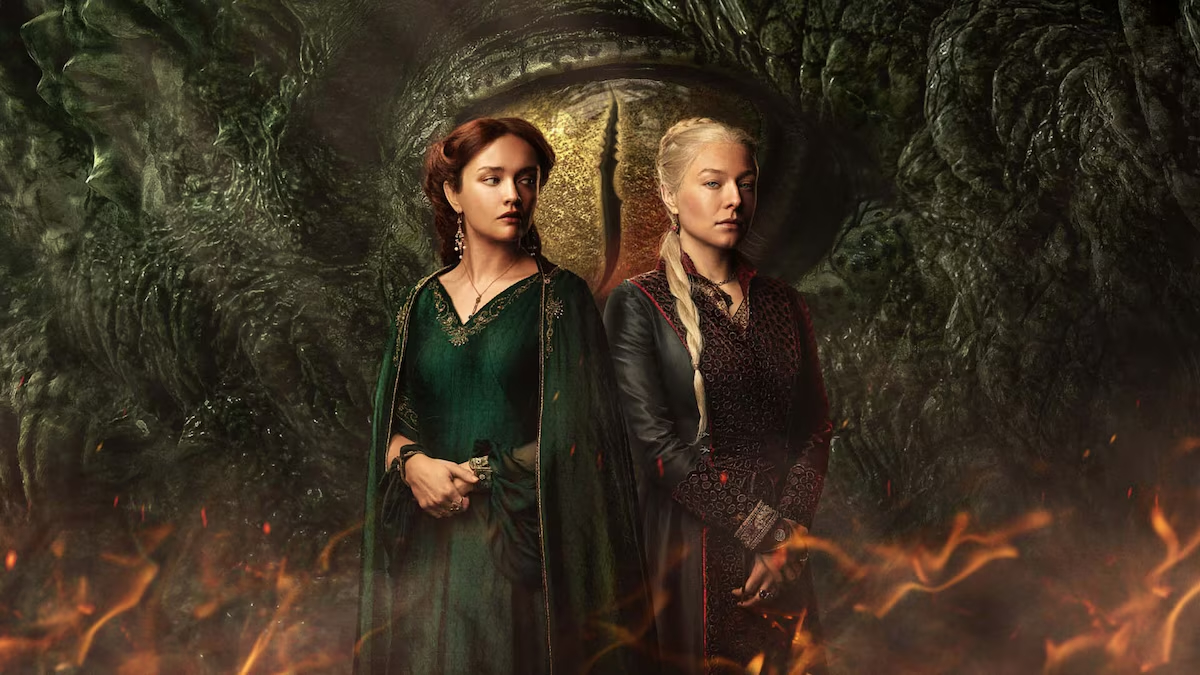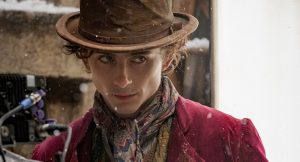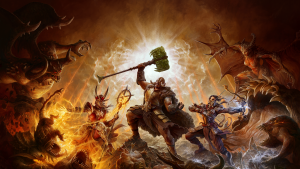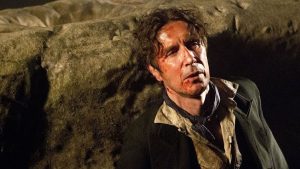
The opening credits for the first season of House of the Dragon took viewers by surprise two years ago. Its first shock was that producers, HBO, and composer Ramin Djawadi opted to reuse Djawdi’s admittedly iconic musical suite written for Game of Thrones more than a decade ago; the second was… figuring out what in the Seven Hells those rivers of blood were about.
While there is a definite beauty and meaning to the season 1 table-setter, with the red streams and tributaries marking each new family member in the Targaryens’ contentious succession from Aegon the Conqueror down through the many children of both Rhaenyra Targaryen (Emma D’Arcy) and Alicent Hightower (Olivia Coke), it was always a little esoteric. So it perhaps is less unexpected to find season 2 has opted for an entirely different opening credits sequence. This time we’re examining the tapestries.
Aye, tapestries, and there is something immediately clever and foreboding about this approach. Once again House of the Dragon is attempting to tell the story of fire and blood that comprises the Targaryens’ legacy, but now the details are a little clearer to viewers. Much like how the original Game of Thrones’ classic opening titles resembled scholars and kings examining a war map in Dragonstone or at the Citadel, the new House of the Dragon opener might represent the tapestries the Mad King ran his fingers through as a child at the Red Keep—or that Robert Baratheon had ripped down from the walls around the Iron Throne. They tell a story we are currently watching unfold… and it seems to be weaving together a tragedy.
The Glory of Old Valyria
The first several images we see woven into eternity depict the majestic sweep of Old Valyria. This is the great, advanced, and possibly evil civilization from which the Targaryens fled hundreds of years ago. The first image depicted in cloth is of the same great palace that Paddy Considine’s King Viserys was attempting to recreate in miniature in the first season. We also see what appears to be a Targaryen bending the knee. That unusual sight is because in Valyria, the Targaryens were actually considered a lesser house—one of many great families who roamed the skies on dragonback.
Daenys the Dreamer?
Perhaps the most cryptic image to decipher in the whole opening is this one of what appears to be a young Targaryen woman cradling the corpse of a family member. We are not certain, but we believe this is Daenys the Dreamer, the Targaryen said to be cursed by the gift of prophecy and vision. It was Daenys who foresaw the apocalyptic Doom of Valyria years before the earth opened up beneath their countrymen’s feet, and it’s Daenys who convinced her father Lord Aenar to move their entire household to Dragonstone—the furthest outpost of Targaryen and Valyrian rule off the shores of Westeros.
The Doom
Speaking of the Doom, here it is represented in all its cataclysmic horror. While the event is obviously modeled after the eruption of Mt. Vesuvius above the Roman city of Pompeii—as well as the legacy of the Roman Empire’s collapse on the arc of European history—we still don’t know what exactly caused George R.R. Martin’s greatest empire to fall. It might’ve been just a geologic catastrophe as the Fourteen Flames (volcanoes) that composed the great hills of Valyria exploded all at once, triggering earthquakes and fire and ash so severe it blotted out the sky killed the dragons. However, some speculate the blood magic the Valyrians used to build their power and bond with their dragons came with a final, devastating price.
Aegon and His Sister Wives
As the subhead says, this is the most famous Aegon in Westerosi history, the one who would be christened Aegon the Conqueror by the maesters of Oldtown. This tapestry seems to recreate his famed sail from Dragonstone to the site that would become King’s Landing. It’s the beginning of the conquest for Aegon and his two sisterly brides Visenya and Rhaenys. Also fun fact: Visenya, the elder sister, rides Vhagar, who is the monstrous mount claimed by the one-eyed Aemond in House of the Dragon.
The Field of Fire
Here we have the the one major battle—if you can call it that—from the Conquest: House Lannister and House Gardener’s doomed attempt to prevent the Targaryen steamroller. After the grim fate of Harrenhal (more on that in a moment), these two rich houses of the Reach and West thought it wiser to meet the Targaryens out in the field. If you don’t recognize the name Gardener, that’s because King Mern IX of Highgarden and his entire army was consumed in dragonfire in a single afternoon. His steward, someone named Harlan Tyrell, was made the new Lord of Highgarden. King Loren Lannister, meanwhile, happened to leave Casterly Rock too late to stand by King Mern Gardener’s side. Funny, that.
Harrenhal the Melty
While we believe the bodies in the literal field represent King Mern and his men, it seems to be part of a larger artistic rendering of the slaughter of all who stood against Aegon I. Hence in the background is definitely the burning ruins of Harrenhal. As a story that was told often in Game of Thrones, Harrenhal was briefly the biggest castle in Westeros. Its great hall had 35 hearths alone. That size and width of its stone walls are why old King Harren Hoare boasted he could resist the Targaryens’ power, safe with his sons (and smallfolk) in his castle. Aegon promised stone too would bend beneath a dragon’s breath, and by nightfall the castle went up like a Roman candle.
The Stark Who Knelt
Old King Torrhen Stark loved his people and his family. He was also well aware that for a thousand generations, his forefathers were the Kings in the North, leaders who held a sacred duty to protect the realm of men from that which lay Beyond the Wall. He could not bear to feed them to the same dragonfire that consumed Harrenhal and Mern’s field. So when he saw those blasted dragons flying toward his army and family, he saved countless lives by bending the knee. The North mockingly remembered him forever after as the King Who Knelt.
A City Rises
It is not entirely true that King’s Landing was created out of nothing. When Aegon and his sisters “landed” at the mouth of Blackwater Bay, there were several fishing villages and hamlets already constructed. Bu atop those humble foundations, Aegon built a great city and a greater seat of power. Surely they would stand there, too, for the rest of time…
Maegor the Cruel Dies on the Throne
We have here a massive jump forward in time to the bitter end of Maegor Targaryen’s reign. Maegor was one of several of Aegon’s sons to ascend the Iron Throne—although he may gotten there because it is rumored his mother Visenya had King Aenys murdered (Aenys was born of Rhaenys, Aegon’s favorite wife). Whatever the case, Maegor ruled as a cruel despot through violence, murder, and even rape. He then was discovered dead by one of his many brides, skewered on the Iron Throne. Some speculate he killed himself out of shame for his debauchery and diminished power (the lords were rising against him); others say the Iron Throne itself rose up and killed him out of spite; more than likely he was murdered by his own subordinates and Kingsguard. Or maybe his unhappy wives got a Westerosi divorce.
The Great Love of Jaehaerys and Alysanne
Good King Jaehaerys I and his beloved wife Alysanne were never meant to wed. As was ancient Valyrian custom, the pair were brother and sister, but one of the reasons Aenys and Maegor’s rules were so contested was the Westerosi smallfolk never much took to the whole incest thing in the first 50 or so years of Targaryen rule. So when the boyish Jaehaerys came up in succession for the throne, his mother and Hand attempted to marry him to almost anyone but his sister. Yet the two shared an affection that would not be denied—as children they married in rebellion and secret on Dragonstone, and by all accounts actually shared a lifelong connection that lasted decades. Indeed, Jaehaerys would live to become the wise old king, a philosopher monarch who presided over 60 years of nigh uninterrupted peace, prosperity, and infrastructure construction.
The Great Council
… Of course the problem of ruling for 60 years in a divine monarchy is that very few are left alive to remember how succession should work, especially if you have no more living male heirs. Jaehaerys outlived all his sons but had so many grandchildren that a crisis became inevitable. Thus the Great Council of Harrenhal, which is also the first scene of the first season of House of the Dragon. Here an old and enfeebled Jaehaerys allows the lords of Westeros to exert their misogyny against Princess Rhaenys (Eve Best), Jaehaerys’ oldest living heir with a good temperament for leadership. Instead the council votes for the scholarly and feckless Viserys, played by Paddy Considine.
A Tale of Two Queens
We are now in the thick of last season’s House of the Dragon where the dueling influences of Princess Rhaenyra Targaryen (played in her youth by Milly Alcock) and Queen Alicent (Emily Carey early on) represent the fraying loyalties of the crown and great houses. On one hand, you have the king’s chosen heir, and on the other her unlikely stepmother of the same age, who during a celebration in Rhaenyra’s honor wears the vibrant emerald colors of House Hightower. Its her father’s house and it creates an instant shorthand for her supporters to display their greater loyalty to the Hightowers’ infant son over the king’s preferred daughter. Also notice said king, daughter, and wife enjoying a last supper, a la episode 8 of season 1.
The Pretender and the Rightful Heir
With this image of Aegon II (Tom Glynn-Carney) and D’Arcy’s Rhaenyra, you have the dueling thrones that will trigger the Dance. It’s the pretender and the rightful heir, but who is who?
The Death of Innocence
Finally we have the last great horror of season one, and the first real casualty of the civil war. Prince Aemond Targaryen (Ewan Mitchell) uses his ferocious Vhagar to kill his cousin Lucerys Velaryon (Elliot Grihault) and his baby dragon. In the show, at least, it’s depicted as an accident instead of cold blooded murder—as it certainly seemed to all outside perspectives, including in the books. Either way, to paraphrase a Lannister, you’d have better luck drinking from a shattered cup than you would at restoring a bloodless peace to Westeros. It is to be war, then.
The post House of the Dragon Season 2: Deciphering What Those New Opening Credits Mean appeared first on Den of Geek.








